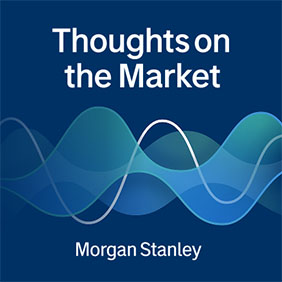Future of Work: AI’s Impact on Industries
November 4, 2025
In the first of a two-part roundtable discussion, our Global Head of Research joins our Global Head of Thematic Research and Head of Firmwide AI to discuss the economic and labor impacts of AI adoption.
Click here to listen to Part 2 of this discussion.

Thoughts on the Market
Listen to our financial podcast, featuring perspectives from leaders within Morgan Stanley and their perspectives on the forces shaping markets today.

Up Next
More Confidence in a Bull Market
Transcript
Welcome to Thoughts on the Market. I'm Mike Wilson, Morgan Stanley’s CIO and Chief U.S. Equity Strategist. Today on the podcast I’ll be discussing recent macro events and third quarter earnings results.
It's Monday, November 3rd at 11:30am in New York.
So, let’s get after it.
Last week marked the passage of two key macro events: the meeting on trade between Presidents Trump and Xi and the October Fed meeting. On the trade front, the U.S. agreed to cut tariffs on China by 10 percent and delay newly proposed tech export controls for a year. In exchange, China agreed to pause its proposed export controls on rare earths, and resume soybean purchases while cracking down on fentanyl. This is a major positive relative to how developments could have gone following the sharp escalation a few weeks ago, and markets have responded accordingly.
With respect to the Fed meeting, Powell suggested policy is not on a preset course which took the bond market probability of a December rate cut down from 92 percent before the meeting to 68 percent currently. It also led to some modest consolidation in equity prices while breadth remained very weak. In my view, the market is saying that if growth holds up but the Fed only cuts rates modestly, leadership is likely to remain narrow and up the quality curve.
Over the next 6 to 12 months, we think moderate weakness in lagging labor data, and a stronger than expected earnings backdrop ultimately sets the stage for a broadening in market leadership. However, we are also respectful of the signals the markets are sending in the near term. This means it's still too early to press the small cap/low quality/deep cyclical rotation trade until the Fed shows a clear willingness to get ahead of the curve. Perhaps just as important for markets was the Fed's decision to end Quantitative Tightening, or QT, in December.
Recently, Jay Powell has acknowledged the potential for rising stress in the funding markets and indicated the Fed could end QT sooner rather than later. Over the past month, expectations for the timing of this QT termination ranged from immediately to as late as February. Powell seemed to split the difference at last week's meeting and this could be viewed as disappointing to some market participants.
In order to monitor this development, I will be watching how short-term funding markets behave. Specifically, overnight repo usage has been on the rise and if that continues along with the widening spreads between the Secured Overnight Financing Rate and fed funds, I believe equity markets are likely to trade poorly, especially in some of the more speculative areas. In short, we think higher quality areas of the market are likely to continue to outperform until this dynamic is settled.
Meanwhile, earnings season is in full swing and the real standout has been the upside in revenue surprises, which is currently more than double the historical run-rate. We think this could provide further support that our rolling recovery thesis is under way which leads to much better earnings growth than most are expecting.
Bottom line, we are gaining more confidence in our core view that a new bull market began in April with the end of the rolling recession and the beginning of a new cycle. This means higher and broader earnings growth in 2026 and a potentially different leadership in the equity market. The full broadening out to lower quality, smaller capitalization stocks is being held back by a Fed that continues to fight inflation; perhaps not realizing how much the private economy and average consumer needs lower rates for this rolling recovery to fully blossom.
Last week’s Fed meeting could be disappointing in that regard in the short run for equity markets. As a result, stay up the quality curve until we get more clarity on the timing of a more dovish path by the Fed and look for stress in funding markets as a possible buying opportunity into year end.
Thanks for tuning in; I hope you found it informative and useful. Let us know what you think by leaving us a review. And if you find Thoughts on the Market worthwhile, tell a friend or colleague to try it out!

How Japan’s Stablecoin Could Reshape Global Finance
Transcript
Welcome to Thoughts on the Market. I’m Mia Nagasaka, Head of Japan Financials Research at Morgan Stanley MUFG Securities.
Today – Japan’s stablecoin revolution and why it matters to global investors.
It’s Friday, October 31st, at 4pm in Tokyo.
Japan may be late to the crypto market. But its first yen-denominated stablecoin is just around the corner. And it has the potential to quietly reshape how digital money moves across the country and globally.
You may have heard of digital money like Bitcoin. It’s significantly more volatile than traditional financial assets like stocks and bonds. Stablecoins are different. They are digital currencies designed to maintain a stable value by being pegged to assets such as the yen or U.S. dollar.
And in June 2023, Japan amended its Payment Services Acts to create a legal framework for stablecoins. Market participants in Japan and abroad are watching closely whether the JPY stablecoin can establish itself as a major global digital currency, such as Tether.
Stablecoins promise to make payments faster, cheaper, and available 24/7. Japan’s cashless payment ratio jumped from about 30 percent in 2020 to 43 percent in 2024, and there’s still room to grow compared to other countries. The government’s push for fintech and digital payments is accelerating, and stablecoins could be the missing link to a truly digital economy.
Unlike Bitcoin or other cryptocurrencies, stablecoins are designed to suppress price volatility. They’re managed by private companies and backed by assets—think cash, government bonds, or even commodities like gold.stablecoins can make digital payments as reliable as cash, but with the speed and flexibility of the internet.
Japan’s regulatory approach is strict: stablecoins must be 100 percent backed by high-quality, liquid assets, and algorithmic stablecoins are prohibited. Issuers must meet transparency and reserve requirements, and monthly audits are standard. This is similar to new rules in the U.S., EU, and Hong Kong.
What does this mean in practice? Financial institutions are exploring stablecoins for instant payments, asset management, and lending. For example, real-time settlement of stock and bond trades normally take days. These transactions could happen in seconds with stablecoins. They also enable new business models like Banking-as-a-Service and Web3 integration, although regulatory costs and low interest rates remain hurdles for profitability.
Or think about SWIFT transactions, the backbone of international payments. Stablecoins will not replace SWIFT, but they can supplement it. Payments that used to take days can now be completed in seconds, with up to 80 percent lower fees. But trust in issuers and compliance with anti-money laundering rules are critical.
There’s another topic on top of investors’ minds. CBDCs – Central Bank Digital Currencies. Both stablecoins and CBDCs are digital. But digital currencies are issued by central banks and considered legal tender, whereas stablecoins are private-sector innovations.
Japan is the world’s fourth-largest economy and considered a leader in technology. But it takes a cautious approach to financial transformation. It is preparing for a CBDC but hasn’t committed to launching one yet. If and when that happens, stablecoins and CBDCs can coexist, with the digital currency serving as public infrastructure and stablecoins driving innovation.
So, what’s the bottom line? Japan’s stablecoin journey is just beginning, but its impact could ripple across payments, asset management, and even global finance.
Thanks for listening. If you enjoy the show, please leave us a review wherever you listen and share Thoughts on the Market with a friend or colleague today.

Sign up to get Morgan Stanley Ideas delivered to your inbox.
Thank You for Subscribing!
Would you like to help us improve our coverage of topics that might interest you? Tell us about yourself.

.jpg/_jcr_content/renditions/wide_16x9.jpg)

